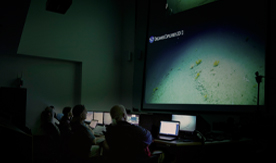
Waller Views Never-Before-Seen Ocean Floor
University of Maine marine scientist Rhian Waller scans a never-before-seen ocean floor during a deep-sea dive in Heezen Canyon near the U.S-Canadian maritime border.
The associate research professor in the School of Marine Sciences is part of an international team exploring the relatively undisturbed ecosystem in hopes of being able to inform decisions about using and protecting the ocean and its resources.
On Aug. 9, Waller spies Paragorgia arborea, aka bubblegum coral, as well as hatchetfish, shrimp and other marine life at a depth of around 2,460 feet. And she does it without moving from her office chair. On this Okeanos Explorer Northeast U.S. Canyons Expedition, Waller is a “scientist from shore.”
While colleagues from the National Oceanic and Atmospheric Administration and the U.S. Geologic Survey dive in NOAA’s 6,000-meter remotely operated vehicle (ROV) Deep Discoverer, Waller shares her expertise from either her office at UMaine’s Darling Marine Center in Walpole, Maine or from the Inner Space Center at the University of Rhode Island’s Graduate School of Oceanography.
“Scientists believe the need to learn more about these relatively undisturbed canyon ecosystems is becoming more urgent, particularly as the potential for fishing, marine mining and hydrocarbon exploration extends into the deep sea,” according to the Okeanos Explorer website.
The team is equipped with state-of-the-art multibeam sonar and a camera sled and lighting platform to provide real-time video footage from the U.S. waters.
The public is invited to go on the dive through Aug. 16 by visiting oceanexplorer.noaa.gov/okeanos/explorations/ex1304.
“This tool is going to open up exploration in the deep-ocean, being able to participate and see areas you might want to go to next before actually having to go to sea yourself, and even find new scientist collaborators to go with you next time,” Waller says.
“Usually you can only have around 20 scientists on a research vessel, and you’re relying on your team’s expertise to be able to identify everything you see. Invariably on deep-sea expeditions you see something new. On this expedition, we don’t have to wait until you get back to shore, all the live ROV feed goes straight to the Internet and, in the background, tens of other scientists are participating by IM or phone line and we can identify animals, ecology and geology right there and then.”
During the first leg of the excursion July 9–24, scientists surveyed about 7,200 square kilometers of seafloor in and around Block, Alvin, Atlantis, Veatch and Hydrographer canyons, says the Okeanos Explorer website. Early reports indicate those canyons contain approximately 25 species of corals — some of which may live 4,000 years and therefore could yield important information about climate and ocean history.
Following is a portion of the July 31 blog entry on the Okeanos Explorer website — the team’s travel day toward the canyons from New York City:
“…Shortly after lunch, the Okeanos Explorer pulled away from pier 36 on the lower east side of Manhattan and headed for sea. There is nothing like getting a sendoff from Lady Liberty herself as we left the city and headed toward the Verrazano Narrows. It is still amazing that it only takes several hours of streaming out of New York until we will be in unexplored deep water. There is no better example of how little we know about the ocean than to realize that there are unexplored regions of the continental slope just 60 to 100 miles offshore. Less than 100 miles offshore from America’s largest city lay places and animals that have never been seen by human eyes…”
Contact: Beth Staples, 207.581.3777
